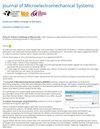Q-Factor Enhancement of Micro Hemispherical Resonators via Optimization of Film Distribution
IF 3.1
3区 工程技术
Q2 ENGINEERING, ELECTRICAL & ELECTRONIC
引用次数: 0
Abstract
Micro hemispherical resonator gyroscopes (mHRG) offer significant advantages such as high precision and good reliability in inertial measurement applications. Thin-film damping of the resonators is a key factor limiting the performance improvement of mHRG. In this paper, we present a 3D mask-based metallization process that achieves ultra-thin 7 nm metallization on resonators through precise thickness distribution control. This method comprehensively analyzes the film thickness distribution and the energy distribution of the resonator, and reduces the film damping by regulating the film thickness distribution on the inner surface of the resonator through a mask. Our results show that this method reduces the film thickness from 13 nm to 7 nm (46.5% reduction) while maintaining the electrical conductivity and improving the Q-factor by 8.4 percentage points. The measured highest Q-factor of the 7 nm thin-film micro hemispherical resonator is 4.19 million, with an average Q-loss rate of 32.2%. Experimental validation confirms that the 7 nm Pt film not only meets the low resistance (通过优化薄膜分布来增强微半球谐振器的q因子
微半球谐振陀螺仪在惯性测量中具有精度高、可靠性好等显著优点。谐振腔的薄膜阻尼是制约mHRG性能提高的关键因素。在本文中,我们提出了一种基于3D掩模的金属化工艺,通过精确的厚度分布控制,在谐振器上实现了超薄的7纳米金属化。该方法综合分析了谐振器的膜厚分布和能量分布,通过掩模调节谐振器内表面的膜厚分布,降低了膜阻尼。结果表明,该方法将薄膜厚度从13 nm减小到7 nm (46.5% reduction) while maintaining the electrical conductivity and improving the Q-factor by 8.4 percentage points. The measured highest Q-factor of the 7 nm thin-film micro hemispherical resonator is 4.19 million, with an average Q-loss rate of 32.2%. Experimental validation confirms that the 7 nm Pt film not only meets the low resistance ( $\le 500~\Omega $ ) requirement, but also reduces the energy dissipation of the resonator by minimizing thermoelastic damping and internal friction. This approach provides an efficient film thickness modulation strategy for mHRG. [2025-0079]
本文章由计算机程序翻译,如有差异,请以英文原文为准。
求助全文
约1分钟内获得全文
求助全文
来源期刊

Journal of Microelectromechanical Systems
工程技术-工程:电子与电气
CiteScore
6.20
自引率
7.40%
发文量
115
审稿时长
7.5 months
期刊介绍:
The topics of interest include, but are not limited to: devices ranging in size from microns to millimeters, IC-compatible fabrication techniques, other fabrication techniques, measurement of micro phenomena, theoretical results, new materials and designs, micro actuators, micro robots, micro batteries, bearings, wear, reliability, electrical interconnections, micro telemanipulation, and standards appropriate to MEMS. Application examples and application oriented devices in fluidics, optics, bio-medical engineering, etc., are also of central interest.
 求助内容:
求助内容: 应助结果提醒方式:
应助结果提醒方式:


